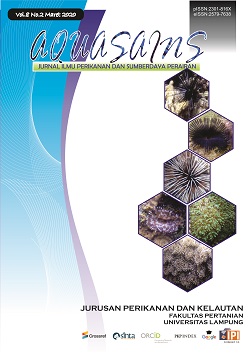Feasibility Analysis of Freshwater Fish Farming Business Development in Pringsewu District
DOI:
https://doi.org/10.23960/aqs.v8i2.p815-828 Abstract View: 433
Abstract View: 433
Abstract
This research has two aims, the first was to see and analyze the business of freshwater fish farming in Pringsewu District which is feasible or not to be developed. The second aim was to find out whether the freshwater fish farming business in Pringsewu District remain feasible to be developed if there was a decrease in production levels and an increased in production costs. This research analyzes several aspects of business feasibility, namely marketing aspect, production aspect, management aspect dan financial aspect. In the financial aspect, two approaches were used, that were analysis of unpaid business feasibility using the Benefit Cost Ratio (B/C Ratio), Break event point (BEP), Return On Invesment (ROI) analysis tools and discounted business feasibility analysis with the Net Present Value (NPV), Net Benefit Cost Ratio (Net B/C), Internal rate of retur (IRR), Gross Benefit Cost Ratio (Gross B/C), Payback period analysis tools. The results of this study indicate that the aspects of marketing, production aspect, and management aspect have the potential to be developed, as well as the financial aspects with the feasibility analysis of non-discounted shows that the business of freshwater fish farming in Pringsewu District is feasible to be developed. The results of the sensitivity analysis also show that the business is still feasible to be developed despite a decline in production levels and an increased in production costs.
Keywords : Business Development, Business Feasibility, Project Evaluation, Freshwater Fish Farming
Downloads
References
Badan Pusat Statistik (BPS) Provinsi Lampung. 2017. Provinsi Lampung dalam Angka 2017. Katalog : 1102001.18.
Badan Pusat Statistik (BPS) Kabupaten Lampung Selatan. 2017. Lampung Selatan dalam Angka 2017. Katalog : 1102001.1803
Gittinger, P. 1986. Evaluasi Proyek. Bhineka Cipta. Jakarta.
Ibrahim, Y. 2003. Studi Kelayakan Bisnis. Edisi Revisi. Rineka Cipta. Jakarta
Munawir, S. 1995. Analisis Laporan Keuangan. Edisi Keempat. Penerbit Liberty Jogja. Yogyakarta
Sugiyono. 2010. Metode Penelitian Bisnis. Alfabeta. Bandung
Riyanto, B. 2011. Dasar-Dasar Pembelajaan Perusahaan. Edisi Keempat Cetakan Ketujuh. YBPFE UGM. Yogyakarta
Downloads
Published
How to Cite
Issue
Section
License
License for Authors
Authors who publish with this journal agree to the following terms:
- Authors retain copyright and grant the journal right of first publication with the work simultaneously licensed under a Creative Commons Attribution License that allows others to share the work with an acknowledgement of the work's authorship and initial publication in this journal.
- Authors are able to enter into separate, additional contractual arrangements for the non-exclusive distribution of the journal's published version of the work (e.g., post it to an institutional repository or publish it in a book), with an acknowledgement of its initial publication in this journal.
- When the article is accepted for publication, its copyright is transferred to Aquasains Journal. The copyright transfer convers the exclusive right to reproduce and distribute the article, including offprint, translation, photographic reproduction, microfilm, electronic material, (offline or online) or any other reproduction of similar nature.
- Authors are permitted and encouraged to post their work online (e.g., in institutional repositories or on their website) prior to and during the submission process, as it can lead to productive exchanges, as well as earlier and greater citation of published work (See The Effect of Open Access).
- The Author warrant that this article is original and that the author has full power to publish. The author sign for and accepts responsibility for releasing this material on behalf os any and all-author. If the article based on or part os student’s thesis, the student needs to sign as his/her agreement that his/her works is going published.
License for Regular Users
Other regular users who want to cite, distribute, remix, tweak, and build upon author’s works, even for commercial purposes, should acknowledge the work’s authorship and initial publication in this journal, licensed under a Creative Commons Attribution License.
This license lets others distribute, remix, tweak, and build upon your work, even commercially, as long as they credit you for the original creation.
This work is licensed under a Creative Commons Attribution 4.0 International License.Copyright Transfer Statement can be downloaded here


.png)









